By John Treadwell Dunbar ——Bio and Archives--February 10, 2011
Travel | CFP Comments | Reader Friendly | Subscribe | Email Us
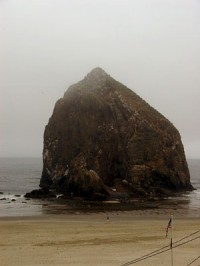 It was a craving for rancid whale blubber that drove Captain William Clark of Lewis and Clark expeditionary fame to trek 25 miles south of the mighty Columbia River in January, 1806, to lofty Tillamook Head on the northern Oregon coast.
Beached whale near Ecola Creek was on the menu, but had the famous explorers known what that rubbery mammal tasted like they might have stayed put.
Some claim it rivals horse meat, has the texture of dirty socks marinated in olive oil, and boiled to perfection smells like your dog's colon. Others argue it tastes just like A-1 Steak Sauce if you're generous.
It was a craving for rancid whale blubber that drove Captain William Clark of Lewis and Clark expeditionary fame to trek 25 miles south of the mighty Columbia River in January, 1806, to lofty Tillamook Head on the northern Oregon coast.
Beached whale near Ecola Creek was on the menu, but had the famous explorers known what that rubbery mammal tasted like they might have stayed put.
Some claim it rivals horse meat, has the texture of dirty socks marinated in olive oil, and boiled to perfection smells like your dog's colon. Others argue it tastes just like A-1 Steak Sauce if you're generous.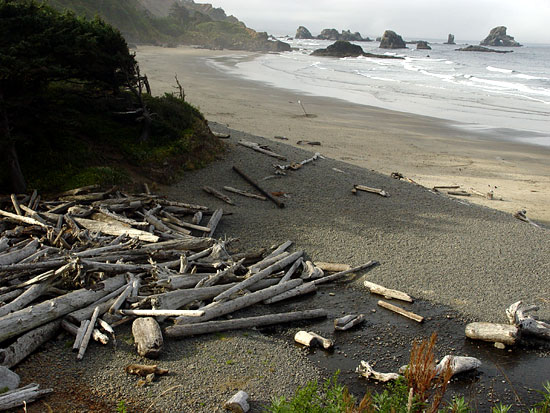 With Indian maiden Sacajawea in tow and the help of fellow adventurers, the blubber-seekers clambered up through towering Sitka spruce. Struggling mightily on their ascent according to the journal, they gained the precipitous rise and were rewarded with stellar views of the never-ending Pacific Ocean - flat water planing to the far horizon, craggy islands below. "I behold," wrote Captain Clark, "the grandest and most pleasing prospect which my eyes ever surveyed."
Except for parking lots on either end of Ecola Park and a six mile interconnecting trail little has changed. The same grand views from atop one-thousand-foot cliffs await modern trekkers. A mile out to sea beyond the rocky headlands, battered and beaten by grinding currents and crushing waves, stands Terrible Tilly, a tiny basalt rock island hosting the Tillamook Rock Lighthouse 130 feet above the angry swells. Decommissioned in 1957, it continues to stand resolute in the face of relentless winter lashings.
With Indian maiden Sacajawea in tow and the help of fellow adventurers, the blubber-seekers clambered up through towering Sitka spruce. Struggling mightily on their ascent according to the journal, they gained the precipitous rise and were rewarded with stellar views of the never-ending Pacific Ocean - flat water planing to the far horizon, craggy islands below. "I behold," wrote Captain Clark, "the grandest and most pleasing prospect which my eyes ever surveyed."
Except for parking lots on either end of Ecola Park and a six mile interconnecting trail little has changed. The same grand views from atop one-thousand-foot cliffs await modern trekkers. A mile out to sea beyond the rocky headlands, battered and beaten by grinding currents and crushing waves, stands Terrible Tilly, a tiny basalt rock island hosting the Tillamook Rock Lighthouse 130 feet above the angry swells. Decommissioned in 1957, it continues to stand resolute in the face of relentless winter lashings.
 Even though the lighthouse outlived its navigational usefulness it projects a spiritual glow in its stead; the memory of loved ones and hope for the deceased. Today, those with means use the lighthouse on Terrible Tilly as a repository for ashes of the departed whose granular remains are ferried by helicopter out to their final resting place.
Bring binoculars because dead people aren't the only ones who call these jagged rocks home. Within sight of those lofty headlands are select fragments of the Oregon Islands National Wildlife Refuge, a designated National Wilderness Area and protected zone of 1,853 reefs and islands that span 320 miles along the incomparable Oregon coast.
Even though the lighthouse outlived its navigational usefulness it projects a spiritual glow in its stead; the memory of loved ones and hope for the deceased. Today, those with means use the lighthouse on Terrible Tilly as a repository for ashes of the departed whose granular remains are ferried by helicopter out to their final resting place.
Bring binoculars because dead people aren't the only ones who call these jagged rocks home. Within sight of those lofty headlands are select fragments of the Oregon Islands National Wildlife Refuge, a designated National Wilderness Area and protected zone of 1,853 reefs and islands that span 320 miles along the incomparable Oregon coast.
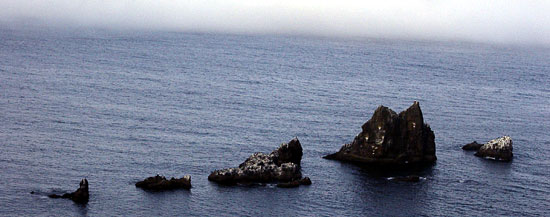 Pelagic Cormorants, Black Oystercatchers, Rhinoceros Auklets and many other feathery friends find refuge in the refuge. Big pinnipeds - that would be your seals and Stellar sea lions - breed little pinnipeds and haul out on exposed outcroppings in large numbers to fellowship and moan. With patience and good timing you should be able to spot migrating gray whales spinning north to Alaska or south to Mexico during spring and fall. And yes, they really do spout large plumes of saltwater - look for that.
Pelagic Cormorants, Black Oystercatchers, Rhinoceros Auklets and many other feathery friends find refuge in the refuge. Big pinnipeds - that would be your seals and Stellar sea lions - breed little pinnipeds and haul out on exposed outcroppings in large numbers to fellowship and moan. With patience and good timing you should be able to spot migrating gray whales spinning north to Alaska or south to Mexico during spring and fall. And yes, they really do spout large plumes of saltwater - look for that.
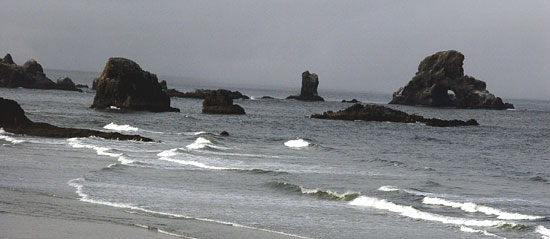 Sooner or later everyone visiting Cannon Beach makes the paved three-mile drive north to Ecola State Park. It's a great place for a head-on collision as the narrow one-lane road dips and turns and winds through a dark tunnel of beautiful old growth Sitka spruce and western hemlock. Watch out for California drivers, they're the worst.
Sooner or later everyone visiting Cannon Beach makes the paved three-mile drive north to Ecola State Park. It's a great place for a head-on collision as the narrow one-lane road dips and turns and winds through a dark tunnel of beautiful old growth Sitka spruce and western hemlock. Watch out for California drivers, they're the worst.
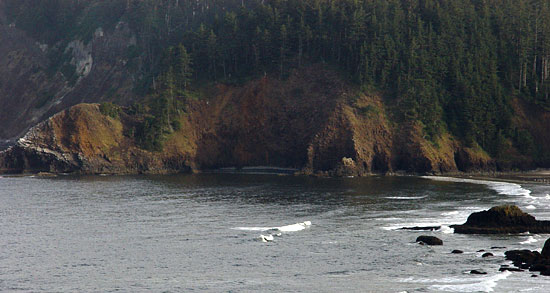 Lathered in furry moss rich in greens fluorescent and bold with gradients in between, the forest is a photographer's delight on overcast, gray days, drizzle notwithstanding - if you can find a safe place to park. Two beaches await you on emerging from the wormhole. Crescent Beach sweeps in a gentle, tantalizing curve south of Ecola Point. It's a playground for picnickers and wandering sages, a wide swath sprawled along the base of green hills that rise abruptly from a sandy beach littered with skeletal remains of large spruce trees bleached white and tossed randomly in heaps by the pounding surf.
Lathered in furry moss rich in greens fluorescent and bold with gradients in between, the forest is a photographer's delight on overcast, gray days, drizzle notwithstanding - if you can find a safe place to park. Two beaches await you on emerging from the wormhole. Crescent Beach sweeps in a gentle, tantalizing curve south of Ecola Point. It's a playground for picnickers and wandering sages, a wide swath sprawled along the base of green hills that rise abruptly from a sandy beach littered with skeletal remains of large spruce trees bleached white and tossed randomly in heaps by the pounding surf.
 Beyond the parking lot, a large rolling lawn, cropped and damp and dotted with picnic tables, has served the movie industry well. It doubled for the school carnival in Arnold Swarzenegger's Kindergarten Cop (1990). That heartwarming tale Free Willy (1993) and The Goonies (1985) were also filmed here. The right fork near the fee station will lead you north to Indian Beach which is popular with surfers. Hollywood shot a few scenes from Point Break (1991) and Twilight (2008) here as well, and for good reason. The scenery is ravishing. And there are tide pools!
My memories of Ecola go back many years, all good. Back then we'd camp in secluded coves on the beach under starry skies and no one cared. The authorities didn't hyperventilate and hunt you down like a dog for trespassing. Back then access to our parks and forests, state and federal, were treated as a right, not a privilege, and financially within everyone's reach. The government didn't pocket a quarter every time you took in the view or breathed fresh air. Free access across the West was expected and graciously tendered, a term of the social contract between them and us, but those days are mere memory. The contract has been broken and sadly the young nowadays don't realize what we've lost.
Beyond the parking lot, a large rolling lawn, cropped and damp and dotted with picnic tables, has served the movie industry well. It doubled for the school carnival in Arnold Swarzenegger's Kindergarten Cop (1990). That heartwarming tale Free Willy (1993) and The Goonies (1985) were also filmed here. The right fork near the fee station will lead you north to Indian Beach which is popular with surfers. Hollywood shot a few scenes from Point Break (1991) and Twilight (2008) here as well, and for good reason. The scenery is ravishing. And there are tide pools!
My memories of Ecola go back many years, all good. Back then we'd camp in secluded coves on the beach under starry skies and no one cared. The authorities didn't hyperventilate and hunt you down like a dog for trespassing. Back then access to our parks and forests, state and federal, were treated as a right, not a privilege, and financially within everyone's reach. The government didn't pocket a quarter every time you took in the view or breathed fresh air. Free access across the West was expected and graciously tendered, a term of the social contract between them and us, but those days are mere memory. The contract has been broken and sadly the young nowadays don't realize what we've lost.
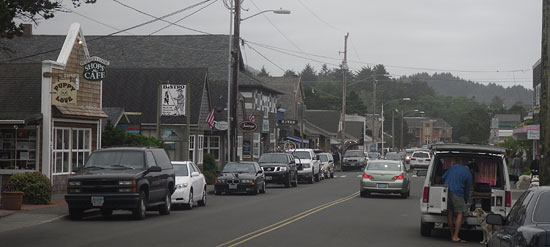 As such, camping at will on Ecola State Park's beaches is not advised in today's commercial climate unless you wish to rile the Sheriff of Nottingham who will most certainly haul you off to the Tower of London for a good stretching. Fortunately, backpackers able and willing to make the slog can hike up to primitive rustic shelters for the night near the summit of Clatsop Loop Trail. Bring water and mind the regulations.
The Cannon Beach of my youth, while a student in my twenties in Portland an hour and a half inland, isn't the same as the Cannon Beach of today. Back then it had funk. Sand covered side streets, hippies hung out with the flies and plucked Grateful Dead licks on their guitars and you could leisurely pick through bins of imported seashells along South Hemlock. For entertainment, an ice chest packed with Coors on a warm sunny day on the beach with your buzzed buddies running amok in the sand chasing Frisbees in the shadow of 235-foot Haystack Rock might have seemed obnoxious to onlookers, but condoned.
As such, camping at will on Ecola State Park's beaches is not advised in today's commercial climate unless you wish to rile the Sheriff of Nottingham who will most certainly haul you off to the Tower of London for a good stretching. Fortunately, backpackers able and willing to make the slog can hike up to primitive rustic shelters for the night near the summit of Clatsop Loop Trail. Bring water and mind the regulations.
The Cannon Beach of my youth, while a student in my twenties in Portland an hour and a half inland, isn't the same as the Cannon Beach of today. Back then it had funk. Sand covered side streets, hippies hung out with the flies and plucked Grateful Dead licks on their guitars and you could leisurely pick through bins of imported seashells along South Hemlock. For entertainment, an ice chest packed with Coors on a warm sunny day on the beach with your buzzed buddies running amok in the sand chasing Frisbees in the shadow of 235-foot Haystack Rock might have seemed obnoxious to onlookers, but condoned.
 Once a befuddled teenager in torn Levis and smelly Reeboks, Cannon Beach has grown up and prospered. Adorned in fine linen and sporting the latest in fashion, this adorable pocket of affluence oozing art and sophistication behind a maritime veneer is a perennial escape for Portland's refugees fleeing metropolitan mayhem on weekends in droves. And good times await them.
Quaint, charming, picturesque ... a touch of Nantucket sprinkled with pixie dust, Cannon Beach is color-coordinated. Mostly grays with some brown, cedar-shingled beach homes and seascape cottages complement steel-gray skies that hover over Oregon's Coast six months out of the year. To lighten the mood, flowers are everywhere; rich, vibrant beds of purple and red and yellow and pink and blue and green; flowers spilling from hanging baskets, lining sidewalks and crowding parkways, all tastefully done, all very orderly and conscientious.
Once a befuddled teenager in torn Levis and smelly Reeboks, Cannon Beach has grown up and prospered. Adorned in fine linen and sporting the latest in fashion, this adorable pocket of affluence oozing art and sophistication behind a maritime veneer is a perennial escape for Portland's refugees fleeing metropolitan mayhem on weekends in droves. And good times await them.
Quaint, charming, picturesque ... a touch of Nantucket sprinkled with pixie dust, Cannon Beach is color-coordinated. Mostly grays with some brown, cedar-shingled beach homes and seascape cottages complement steel-gray skies that hover over Oregon's Coast six months out of the year. To lighten the mood, flowers are everywhere; rich, vibrant beds of purple and red and yellow and pink and blue and green; flowers spilling from hanging baskets, lining sidewalks and crowding parkways, all tastefully done, all very orderly and conscientious.
 Known today as one of America's great art towns of its size, the village proper features distinct artistic enclaves, winding brick-paved walkways leading through stylish recesses that open to courtyards lined with fine art galleries and coffee shops, bakeries and boutiques. Espresso sippers and hobnobbers peruse Proust on wood benches near ponds and gurgling fountains and otherwise linger and shop the many specialty stores. Cannon Beach provides all the amenities one expects from that particular crust ... fine dining, luxurious lodging, retreats and conferences and festivals galore. For a laundry list of the wheres, the whats and the hows, Google the town. It's all very nice, very clean and intentional if your tastes run that way. Now, if they can just do something about the parking.
As time goes on I spend less and less of it in Cannon Beach. The crowds have something to do with that I suppose. But should you be driving down the 101, by all means swing by and explore. Ecola State Park is not something to be missed. Maybe you'll fall in love with this delightful coastal village like I first did; snug and salty, tucked low in the moss-draped coastal rainforest, sometimes wet, often dripping, frequently fogged in and occasionally sunny and clear. Arguably, it's the classiest coastal village of its kind in the Northwest. That's saying something.
Known today as one of America's great art towns of its size, the village proper features distinct artistic enclaves, winding brick-paved walkways leading through stylish recesses that open to courtyards lined with fine art galleries and coffee shops, bakeries and boutiques. Espresso sippers and hobnobbers peruse Proust on wood benches near ponds and gurgling fountains and otherwise linger and shop the many specialty stores. Cannon Beach provides all the amenities one expects from that particular crust ... fine dining, luxurious lodging, retreats and conferences and festivals galore. For a laundry list of the wheres, the whats and the hows, Google the town. It's all very nice, very clean and intentional if your tastes run that way. Now, if they can just do something about the parking.
As time goes on I spend less and less of it in Cannon Beach. The crowds have something to do with that I suppose. But should you be driving down the 101, by all means swing by and explore. Ecola State Park is not something to be missed. Maybe you'll fall in love with this delightful coastal village like I first did; snug and salty, tucked low in the moss-draped coastal rainforest, sometimes wet, often dripping, frequently fogged in and occasionally sunny and clear. Arguably, it's the classiest coastal village of its kind in the Northwest. That's saying something.
 Certain Cannon Beach memories from years gone by stand out in my mind. I remember pulling into an empty parking lot near the water's edge at three in the morning after a numbing four-day drive down from Alaska. I sat wearily in thick fog behind the wheel craving sound sleep while an overhead streetlight shed amber. Then, out of the grainy mist strolled a small herd of Roosevelt Elk. Certain I was hallucinating, I rubbed my eyes and leaned forward for a better look as the stocky beasts in thick brown hides strolled around the car undaunted, sniffing splattered bugs on the grill, snorting vapor clouds, gazing at us with big brown eyes, then strolling off to the sandy beach and vanishing behind a misty curtain as rolling waves pounded the earth and roared and hissed and slid gently back into the watery fold.
Certain Cannon Beach memories from years gone by stand out in my mind. I remember pulling into an empty parking lot near the water's edge at three in the morning after a numbing four-day drive down from Alaska. I sat wearily in thick fog behind the wheel craving sound sleep while an overhead streetlight shed amber. Then, out of the grainy mist strolled a small herd of Roosevelt Elk. Certain I was hallucinating, I rubbed my eyes and leaned forward for a better look as the stocky beasts in thick brown hides strolled around the car undaunted, sniffing splattered bugs on the grill, snorting vapor clouds, gazing at us with big brown eyes, then strolling off to the sandy beach and vanishing behind a misty curtain as rolling waves pounded the earth and roared and hissed and slid gently back into the watery fold.View Comments
John Treadwell Dunbar is a freelance writer